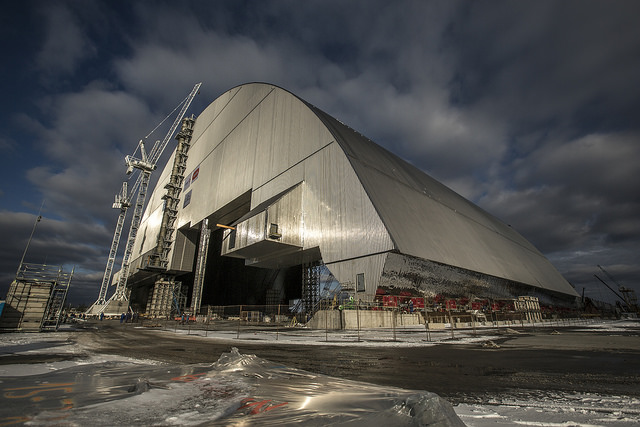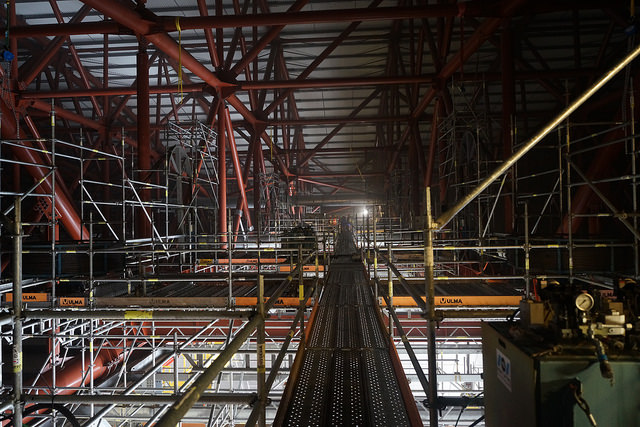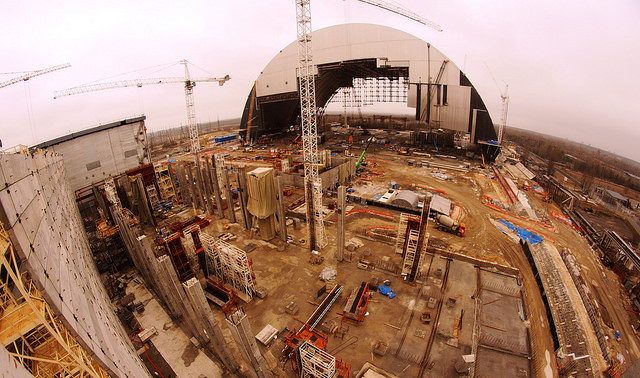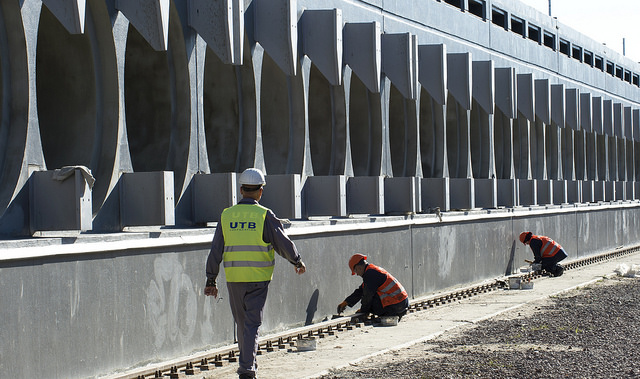Just recently in Ukraine, the fourth unit of the Chornobyl nuclear power station was covered with a new sarcophagus called "New Safe Containment." This structure will ensure 100 years of protection over the radioactive wreckage of the largest man-made accident in history, where in 1986 an explosion followed by a fire contaminated areas in Belarus, Ukraine, and Russia. It is the largest mobile structure in the world, having a mass equal to six Eiffel towers - 36,200 tons and was constructed by specialists from 30 countries.
Joerg Drescher from Euromaidan Press spoke to Balthasar Lindauer, deputy director of the Chornobyl Shelter Fund of the European Bank for Reconstruction and Development (EBRD), who was responsible for the financial administration of the Chornobyl Shelter Fund, about the finishing of the New Safe Containment.
A video uploaded by the Ministry of Ecology of Ukraine shows how the arch of the sarcophagus slid over the fourth reactor

Mr. Lindauer, would you please introduce yourself and your role in the Chornobyl project.
I work for the Nuclear Safety Department of the European Bank for Reconstruction and Development which was entrusted to manage the fund that finances the so-called Shelter Implementation Plan for the construction of the New Safe Confinement in Chornobyl.
About funding: who financed the “New Safe Containment” (NSC)? Who was involved in the planning of the construction?
The funding of this project is an international effort of 45 donor countries and organizations. It was initiated by the G7-countries who are also the largest contributors. A large additional part is paid by the European Bank for Reconstruction and Development itself. The overall costs of the New Safe Confinement is $2 bn of which $500 mn are provided by the EBRD. The rest comes from donor countries.
Is Russia involved, too?
Yes, Russia is involved with a large contribution.
And what people were involved in the planning?
Well, this has been a very long project. It is a unique challenge and it had to go through several steps to determine what is the best technical solution. So the initial planning was done by a group of Ukrainian and international experts who developed the so-called Shelter Implementation Plan. This was a very rough guide how to approach this problem. Then we had a project management unit in place which consists of international experts and staff of the Chornobyl Nuclear Power Plant. They developed an approach which was the basis of the tender. The technical job was awarded to the Novarka consortium formed by the French companies Bouygues
and Vinci. They developed a detailed design which now has been implemented.
Maybe you had heard about the doubts of Mr. Kostenko, the former Minister of Ecology and nuclear safety of Ukraine in 1992 to 1998. He gave an interview in April this year in which he said that this NSC seemed to be just a construction to hide the problem. He also opined that this NSC will not survive the expected 100 years, as nobody really knows how radiation will impact the construction. The first sarcophagus had the same fate. Do you share these doubts on behalf of the construction?
The former minister is a very distinguished person. He has contributed greatly to put this project in place. But I do not agree with his assessment. The New Safe Confinement is not a shell to simply cover the old reactor. The whole point of this facility is that it will be equipped with systems being able to do the deconstruction works and ultimately to retrieve the radioactive inventory of the site. So it is an active facility and not a passive shell.
The design takes into account all kind of impacts during its lifetime. And a lot of effort has been spent in measures ensuring that the NSC can withstand 100 years easily or probably even a longer period. So, things like corrosion and of cause radiation exposure have been taken into account.
What about further activities? Are they already funded?
The current mandate of the Chornobyl Shelter Fund managed by the EBRD is to complete the facility and to hand it over to Ukraine. And then it will be the task of Ukraine to decide when and how to best use it. We do already have a study for the deconstruction of the old sarcophagus. But it is Ukraine's task to implement this plan very quickly after the NSC has been handed over. The whole purpose of the long lifetime of this facility is that Ukraine will have the luxury to plan and prepare the next steps very carefully. So there is sufficient time to develop technologies and approaches to deal with further tasks.
Ukraine was and is still considered to be a very corrupt country. Have you personally come in touch with corruption? Did corruption play a role during the building the NSC? And if yes, how much money do you believe was lost in “dark channels” due to the construction?
We are fully aware that corruption is a risk in this country and in many other countries as well. The EBRD has been implementing many projects in Eastern Europe and countries of the former Soviet Union, and we are very confident that we have a very robust system of controls. Our business model aims to minimize the risk of corruption. So I am very confident that the international funds that we have managed have not been used for any other purposes.
Almost three years ago there was a revolution in Ukraine. Did this fact have any influence on the construction? And was there a change after the revolution? For example: did the devaluation of the currency play a role for this project?
Luckily, the difficulties in the country did not have any direct impact on the project. The project could be continued unimpeded. But it is true that the financial and economic difficulties of this country had a certain impact. Ukraine is an important contributor to this project by providing all kinds of services. We understand that this is a huge burden for Ukraine and it is very difficult for them to deliver what they have promised. But we also acknowledge that this is a huge priority for Ukraine and they did their job remarkably well.
This revolution was called “revolution of dignity”. Some people believe it would have been better to spend the money first of all for the so-called liquidators who helped immediately after the disaster and then for building the NSC. Could you please say a few words on social programs for these liquidators and other victims of the disaster to ensure their dignity?
There are of course competing needs and it is always difficult to make decisions on what should be the top priority. We as the managers of this fund were assigned to carry out this particular task. Of course, other tasks are also very important, but we are not involved in them. Some of our donor countries, in particular, the European Union and also the United States, had different bilateral projects to help with other consequences of the accident.
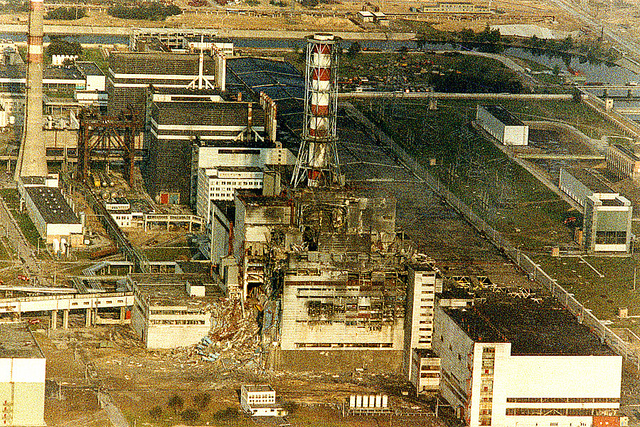
Who gave this task to you? Was it Ukraine?
Initially, the G7 and Ukraine had developed an approach how to tackle this and they have jointly decided that EBRD would be a suitable organization to implement this. So it was initially indeed Ukraine with its representative Mr. Kostenko. And the G7 approached us to set up this fund.
And my last question: here in Ukraine we have an ongoing war. Does this war have any influence on the Chornobyl project? And what about the risk of stealing radioactive material from the site to build a so-called “dirty bomb”?
Well, I spoke about the impact. The project has not been directly impacted by the developments in the country, neither by the conflict in the East. It had contributed to the economic situation in Ukraine which does certainly create a difficult situation for Ukraine.
We are not in charge of the site as a whole. That is something Ukrainian authorities do. They are in charge of the safety and security. We do, however, insist that wherever we get involved highest international standards on safety and security are applied. This goes also for the physical protection of the site and materials. That is all I can say.

